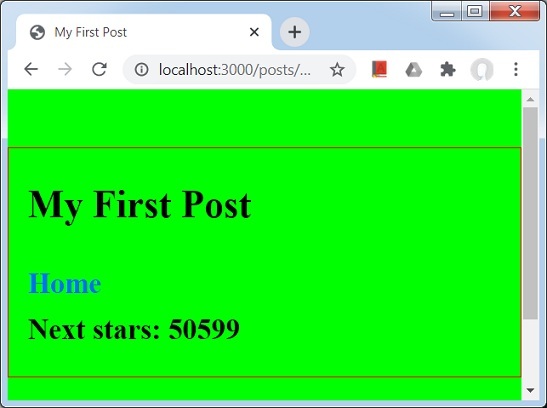- next js 找到所有的重新渲染 - Javascript (1)
- next js 找到所有的重新渲染 - Javascript 代码示例
- 禁用服务器端渲染 next.js - Javascript (1)
- 禁用服务器端渲染 next.js - Javascript 代码示例
- Next.js 安装(1)
- Next.js 安装
- Next.js-元数据
- Next.js-元数据(1)
- 什么是 next.js - Javascript (1)
- Next.js-页面
- Next.js-页面(1)
- Python next()
- Python next()(1)
- 渲染 - Javascript (1)
- Next.js教程
- Next.js教程(1)
- 什么是 next.js - Javascript 代码示例
- 讨论Next.js(1)
- 讨论Next.js
- .next() 方法 (1)
- Next.js-概述
- Next.js-概述(1)
- Next.js-CLI
- Next.js-CLI(1)
- Next.js-路由(1)
- Next.js-路由
- 反应JS |渲染元素
- Next.js 介绍
- Next.js 介绍(1)
📅 最后修改于: 2020-10-22 06:45:50 🧑 作者: Mango
在Next.js中,我们知道它会为称为预渲染的页面生成HTML。 Next.JS支持两种类型的预渲染。
-
静态生成-此方法在生成时生成HTML页面。每次请求时都会发送此预渲染的HTML。此方法对于营销网站,博客,列出wesites,帮助和文档网站的电子商务产品很有用。
-
服务器端生成-此方法在每个请求上生成HTML页面。当html页面的内容随每个请求而变化时,此方法适用。
每页预渲染
Next.JS允许为每个页面设置预渲染方法,其中大多数页面遵循静态生成,而其他页面将使用服务器端渲染。
没有数据的静态生成
静态生成可以在没有数据的情况下完成,在这种情况下,HTML页面将准备就绪,无需预取数据,然后开始呈现。数据可以稍后获取或应要求获取。此技术有助于向用户显示没有任何数据的用户界面,以防数据花费时间。
静态生成数据
静态生成可以使用数据完成,在这种情况下,HTML页面只有在获取数据后才能准备就绪,因为HTML可能取决于数据。每个组件都有一个特殊的方法getStaticProps ,可用于获取数据并将数据作为页面的props传递,以便页面可以根据传递的props呈现。
getStaticProps()函数在生产环境中的构建时运行,并在开发人员模式下针对每个请求运行。
让我们创建一个示例来演示相同的内容。
在此示例中,我们将创建一个更新index.js和first.js页面,以使服务器命中以获取数据。
让我们更新“全局CSS支持”一章中使用的nextjs项目。
更新页面目录中的index.js文件以使用getServerSideProps()方法。将根据每个请求调用此方法。
import Link from 'next/link'
import Head from 'next/head'
function HomePage(props) {
return (
<>
Welcome to Next.js!
Welcome to Next.js!
First Post
Next stars: {props.stars}
 >
)
}
export async function getServerSideProps(context) {
const res = await fetch('https://api.github.com/repos/vercel/next.js')
const json = await res.json()
return {
props: { stars: json.stargazers_count }
}
}
export default HomePage
>
)
}
export async function getServerSideProps(context) {
const res = await fetch('https://api.github.com/repos/vercel/next.js')
const json = await res.json()
return {
props: { stars: json.stargazers_count }
}
}
export default HomePage
更新页面目录中的first.js文件以使用getStaticProps()方法。此方法将被调用一次。
import Link from 'next/link'
import Head from 'next/head'
import Container from '../../components/container'
export default function FirstPost(props) {
return (
<>
My First Post
My First Post
Home
Next stars: {props.stars}
>
)
}
export async function getStaticProps() {
const res = await fetch('https://api.github.com/repos/vercel/next.js')
const json = await res.json()
return {
props: { stars: json.stargazers_count }
}
}
启动Next.js服务器
运行以下命令以启动服务器-。
npm run dev
> nextjs@1.0.0 dev \Node\nextjs
> next
ready - started server on http://localhost:3000
event - compiled successfully
event - build page: /
wait - compiling...
event - compiled successfully
event - build page: /next/dist/pages/_error
wait - compiling...
event - compiled successfully
验证输出
在浏览器中打开localhost:3000,您将看到以下输出。

单击“第一篇文章”链接。
